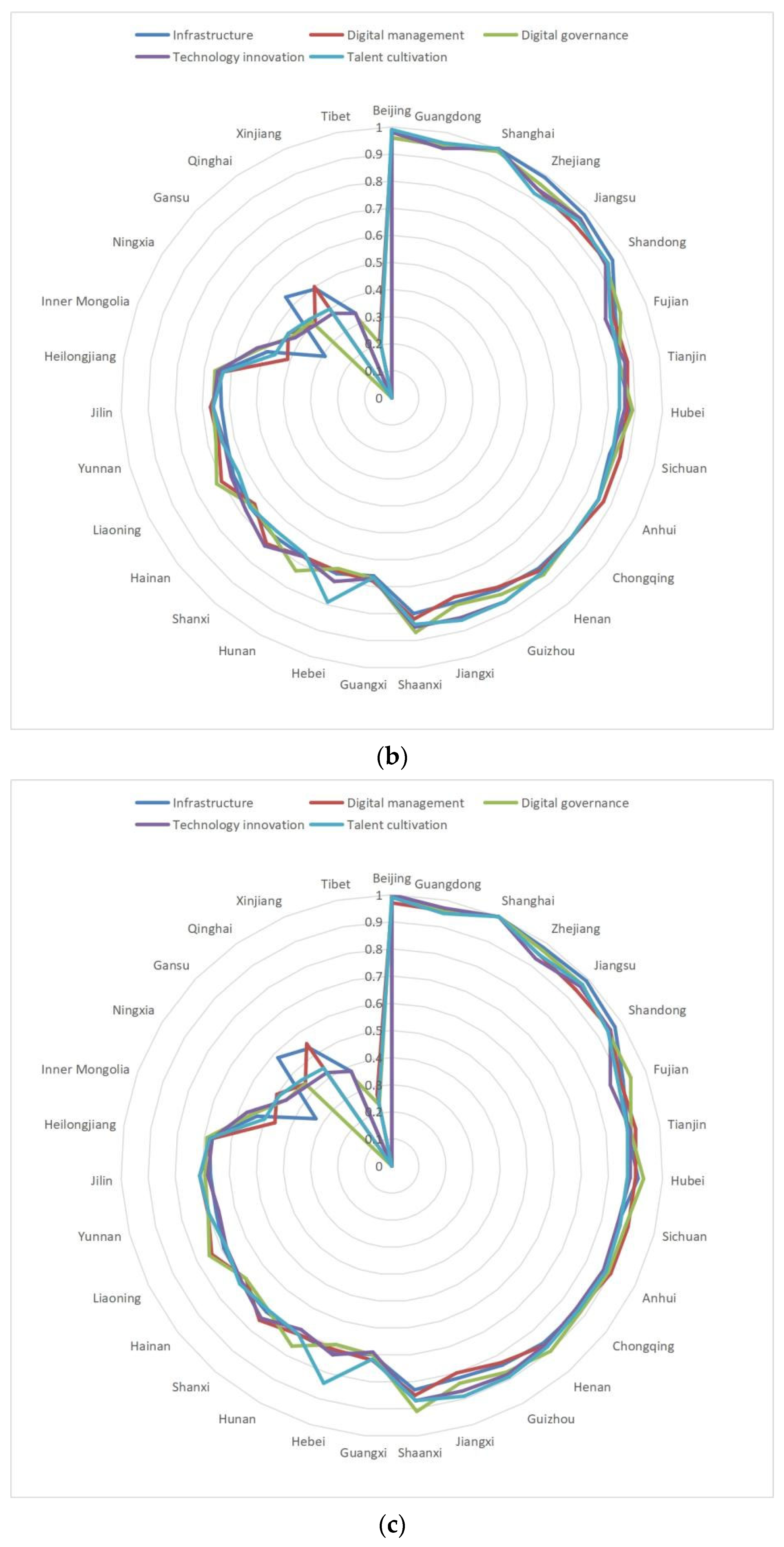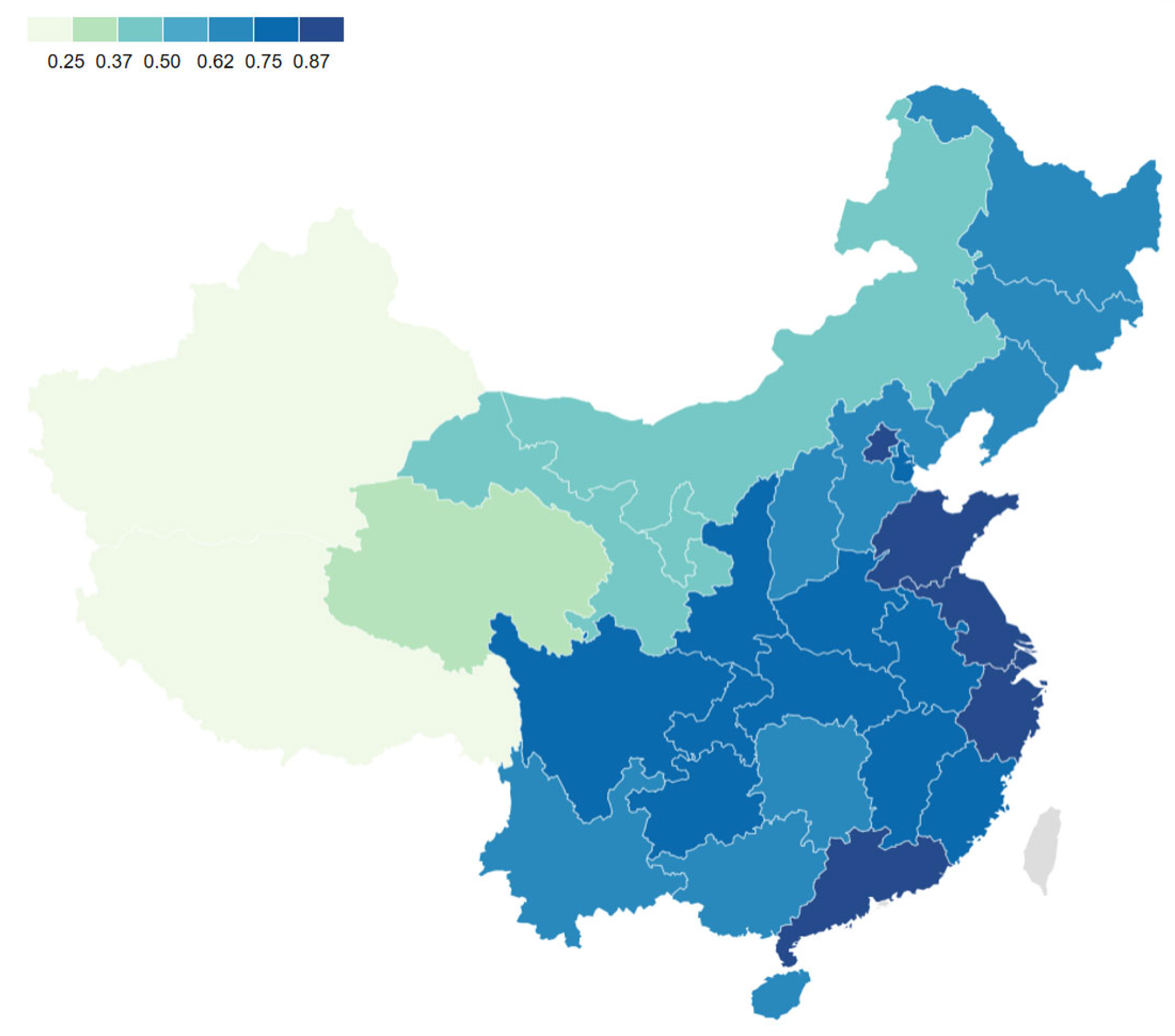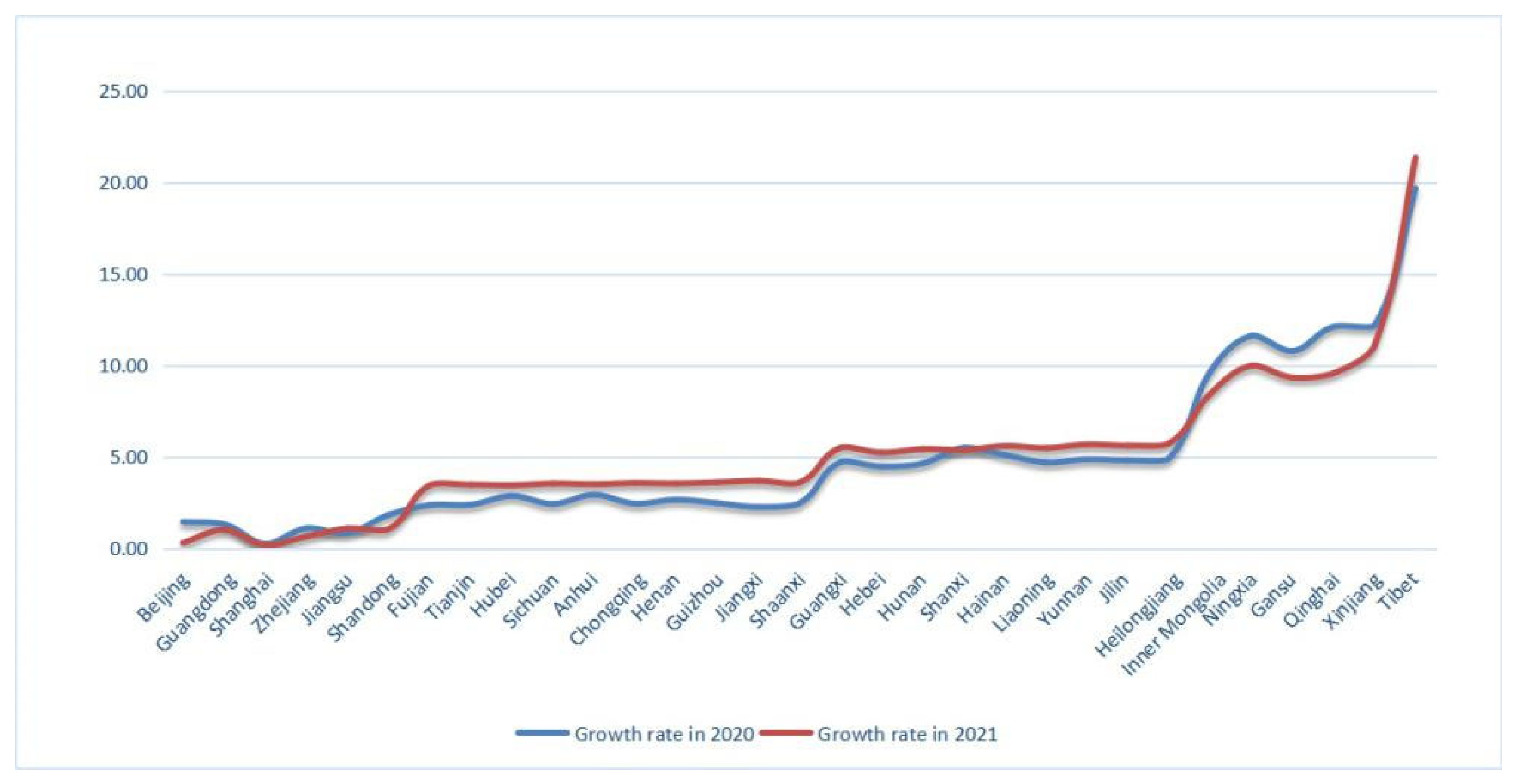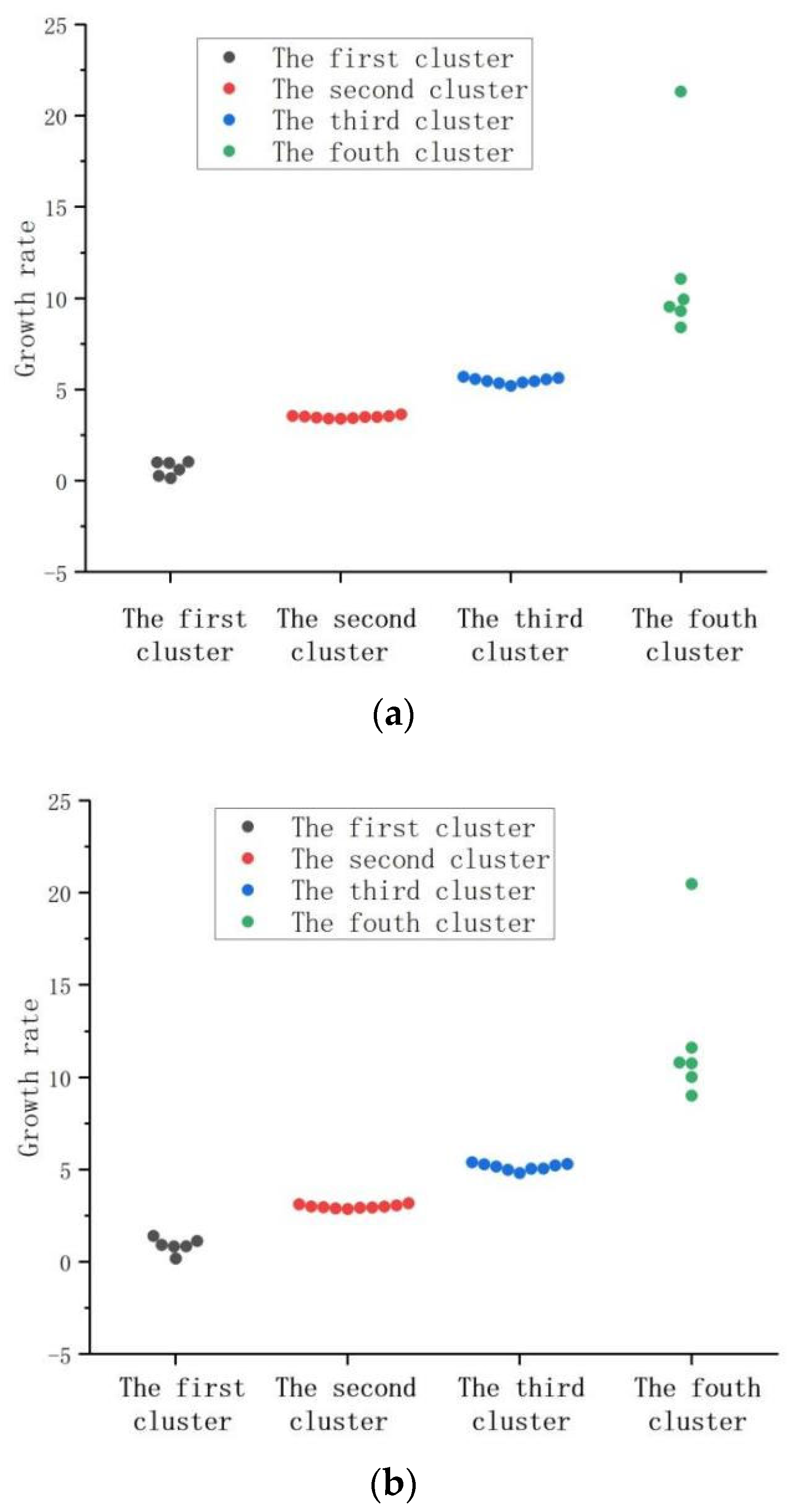Research on the Development Level of Rural E-Commerce in China Based on Analytic Hierarchy and Systematic Clustering Method
Abstract
:1. Introduction
2. Literature Review
3. Construction of Indicator System
4. Empirical Analysis
4.1. Data Sources
4.2. Weight Calculation
- (1)
- Suppose that the judgment matrix determined by the experts is as follows:
- (2)
- The consistency test was conducted on the above matrix, and the specific formula is as follows:where n is the number of parameters participating in the evaluation, λmax is the maximum eigenvalue, and RI is the mean random consistency index. If the CR calculation result is less than the threshold value, it can be considered that the results of the above judgment matrix can be used; otherwise, the judgment matrix is further corrected until the test is satisfied [37,38,39].
- (3)
- After completing the consistency test, geometric averaging was performed according to the method, and the weight size of the target index is:
4.3. Assessment of the Level of Development
4.4. Clustering Analysis
5. Conclusions
- (1)
- The first three indicators of comprehensive weight are infrastructure, digital operation and talent cultivation, whose weights are 0.2234, 0.2113 and 0.2091, respectively. Therefore, if the government wants to realize the rapid improvement in the development level of rural e-commerce, it can pay more attention to the above three indicators when making policies.
- (2)
- At present, the overall development level of rural e-commerce in China shows a positive trend. Based on the data of the past three years, China’s provinces can be divided into four categories. The first category is the overall leading type, which is the highest level of development and the slowest growth rate, including Beijing, Guangdong, Shanghai, Zhejiang, Jiangsu, Shandong and Fujian. Tianjin, Hubei, Sichuan, Anhui, Chongqing, Henan, Guizhou, Jiangxi and Shaanxi are in the growth category, which is characterized by a high level of development and low speed of development. The third category is to catch up with the strong, big players, that is, the development level is low and the development speed is fast, and it includes Guangxi, Hebei, Hunan, Shanxi, Hainan, Liaoning, Yunnan, Jilin and Heilongjiang. The fourth category is rapid development, that is, the lowest level of development and the fastest development, including Inner Mongolia, Ningxia, Gansu, Qinghai, Xinjian and Tibet.
- (3)
- From the perspective of geographical pattern, the development of rural e-commerce in China is characterized by the south being superior to the north and the east superior to the west. The Yangtze River Delta is the region with the highest level of development, which mainly benefits from the developed infrastructure construction, mature talent cultivation system and proactive innovation consciousness in this region.
- (4)
- In order to better promote the high-quality development of rural e-commerce, research shows that the following aspects should be started: First, promote the popularization of new infrastructure in rural areas and accelerate the coverage of digital infrastructure construction. Second, guide the development of rural digital e-commerce to be normalized, and strengthen the construction of farmers’ operational thinking, rural digital-market brand cultivation, digital-market risk circulation and other aspects. Third, promote the modernization of the rural digital governance system and mechanism and improve the system and system construction of modern agricultural operation organization. Fourth, realize the whole process of digital technology attached to rural e-commerce and promote technological innovation in the process of technology application. Fifth, stimulate the role of farmers’ all-round positioning, and make full use of compulsory education, vocational education, and skills training to revitalize rural human resources.
6. Limitations and Further Study
Funding
Institutional Review Board Statement
Informed Consent Statement
Data Availability Statement
Conflicts of Interest
References
- Zhang, L.Y. Research on Multidimensional Relative Poverty Measurement in China’s Rural Areas in the Post Poverty Alleviation Era. World Sci. Res. J. 2021, 7, 99–108. [Google Scholar]
- Su, L.; Peng, Y.; Kong, R.; Chen, Q. Impact of E-Commerce Adoption on Farmers’ Participation in the Digital Financial Market: Evidence from Rural China. J. Theor. Appl. Electron. Commer. Res. 2021, 16, 1434–1457. [Google Scholar] [CrossRef]
- Yang, L.M.; Nan, N.; Qian, P.P. Evaluation of E-commerce Poverty Alleviation Effect in the Context of Rural Revitalization Strategy. Asian Agric. Res. 2019, 11, 57–61. [Google Scholar]
- Wang, A. Cross-border E-commerce Ushers in New Normal. China’s Foreign Trade 2021, 2, 15. [Google Scholar]
- Hu, R.Z. Digital Economy Empowers China’s Rural Revitalization:Current Situations, Problems and Recommendations. Asian Agric. Res. 2021, 13, 18–20. [Google Scholar]
- Yu, G.; Xiang, H. Rural E-commerce development and farmers’ digital credit behavior: Evidence from China family panel studies. PLoS ONE 2021, 16, e0258162. [Google Scholar] [CrossRef]
- Peng, Y.Q.; Gao, K.; Liu, D.; Zhang, M.; Ji, G.; Xu, Y. Development of Rural E-commerce from the Perspective of Agricultural New Kinetic Energy Cultivation:Based on Survey on the “E-commerce Entering Villages and Households” Project of Jurong City. Asian Agric. Res. 2019, 11, 73–78. [Google Scholar]
- Wu, J.; Jia, Y. Analysis on the Problems in the Rural E-commerce Logistics in China under the Spatial Perspective. Adv. Econ. Manag. 2019, 1, 21–27. [Google Scholar] [CrossRef]
- Scarcella, L. E-commerce and effective VAT/GST enforcement: Can online platforms play a valuable role? Comput. Law Secur. Rev. 2019, 36, 105371. [Google Scholar] [CrossRef]
- Li, Y.; Yang, L.J. Research on Rural E-commerce in Zibo City, Shandong Province under the Background of Rural Revitalization. J. Innov. Soc. Sci. Res. 2022, 9, 57–60. [Google Scholar] [CrossRef]
- Zhang, Y.L. Research on Cultivation Strategy of E-commerce Talents in Guangxi Tea Industry under the Background of Rural Revitalization. Front. Educ. Res. 2022, 5, 83–87. [Google Scholar] [CrossRef]
- Xia, H.S.; Weng, J.; Zhang, J.Z.P.; Gao, Y.M. Rural E-Commerce Model with Attention Mechanism: Role of Li Ziqi’s Short Videos from the Perspective of Heterogeneous Knowledge Management. J. Glob. Inf. Technol. Manag. 2022, 25, 118–136. [Google Scholar] [CrossRef]
- Huang, L.; Huang, Y.; Huang, R.; Xie, G.; Cai, W. Factors Influencing Returning Migrants’ Entrepreneurship Intentions for Rural E-Commerce: An Empirical Investigation in China. Sustainability 2022, 14, 3682. [Google Scholar] [CrossRef]
- Liu, C.Y.; Li, J.L.; Liu, J. Rural E-commerce and New Rural Business Model: A Case Study of “Taobao Village” in Jiangsu Province. Asian Agric. Res. 2015, 7, 35–46. [Google Scholar]
- Haji, K. E-commerce development in rural and remote areas of BRICS countries. J. Integr. Agric. 2021, 20, 979–997. [Google Scholar] [CrossRef]
- Peng, C.; Ma, B.; Zhang, C. Poverty alleviation through e-commerce: Village involvement and demonstration policies in rural China. J. Integr. Agric. 2021, 20, 998–1011. [Google Scholar] [CrossRef]
- Liu, M.; Min, S.; Ma, W.; Liu, T. The adoption and impact of E-commerce in rural China: Application of an endogenous switching regression model. J. Rural Stud. 2021, 83, 106–116. [Google Scholar] [CrossRef]
- Outline of the 14th Five-Year Plan (2021–2025) for National Economic and Social Development and Vision 2035 of the People’s Republic of China. Available online: https://www.waizi.org.cn/doc/121096.html (accessed on 13 July 2022).
- Fang, L. Analysis and Reflection on the Spatial Distribution of Taobao Village in Henan Province under the Background of Digital Economy. Sci. J. Econ. Manag. Res. 2021, 3, 115–123. [Google Scholar]
- Fei, X.T. From the Soil: The Foundations of Chinese Society; Observatory Press: Shanghai, China, 1948. [Google Scholar]
- Chen, H.W.; Zhang, J.X. Taobao Villages: Rural development transformation driven by the space of flow. City Plan. Rev. 2018, 9, 93–101. [Google Scholar]
- Wang, L.; Yun, Y.; Ni, J. The geo-space of Taobao village in China: Theoretical framework based on space of flows. City Plan. Rev. 2017, 6, 27–34. [Google Scholar]
- Baorakis, G.; Kourgiantakis, M.; Migdalas, A. The impact of e-commerce on agro-food marketing: The case of agricultural cooperatives, firms and consumers in Crete. Br. Food J. 2002, 104, 580–590. [Google Scholar] [CrossRef]
- Huang, L.; Xie, G.; Huang, R.; Li, G.; Cai, W.; Apostolidis, C. Electronic Commerce for Sustainable Rural Development: Exploring the Factors Influencing BoPs’ Entrepreneurial Intention. Sustainability 2021, 13, 10604. [Google Scholar] [CrossRef]
- Zhang, C.; Zhang, G.S.; Wang, Y.L. Co-evolution and Policy Optimization of Rural E-commerce and Rural Logistics under Government Poverty Alleviation. J. Beijing Jiaotong Univ. 2020, 19, 98–105. [Google Scholar]
- Zhou, J.; Yu, L.; Choguill, C.L. Co-evolution of Technology and Rural Society: The Blossoming of Taobao Villages in the Information Era, China. J. Rural Stud. 2021, 83, 81–87. [Google Scholar] [CrossRef]
- Agricultural Industry Observation. Alibaba Jingdong Pinduoduo to Promote the Development of Rural E-Commerce; Project Recommendation: Jingdong Plant Factory. Available online: https://baijiahao.baidu.com/s?id=1627431412740620971&wfr=spider&for=pc (accessed on 10 July 2022).
- Ministry of Commerce of China. E-Commerce in China; China Commerce and Trade Press: Beijing, China, 2019.
- Wang, C.A.; Miao, J.T.; Phelps, N.A.; Zhang, J. E-commerce and the Transformation of the Rural: The Taobao Village Phenomenon in Zhejiang Province, China—ScienceDirect. J. Rural Stud. 2021, 81, 159–169. [Google Scholar] [CrossRef]
- Leng, C.; Ma, W.; Tang, J.; Zhu, Z. ICT adoption and income diversification among rural households in China. Appl. Econ. 2020, 52, 3614–3628. [Google Scholar] [CrossRef]
- Wang, Y.; Zhang, Q.; Li, Q.; Wang, J.; Sannigrahi, S.; Bellingrath-Kimura, S.D.; Li, J.; Song, C. Role of social networks in building household livelihood resilience under payments for ecosystem services programs in a poor rural community in China. J. Rural Stud. 2021, 86, 208–225. [Google Scholar] [CrossRef]
- Zhao, Y.; Wang, L.; Tang, H.; Zhang, Y. Electronic word-of-mouth and consumer purchase intentions in social e-commerce. Electron. Commer. Res. Appl. 2020, 41, 100980. [Google Scholar] [CrossRef]
- Zhang, H.; Du, K.; Jin, B. Research on Readiness Evaluation of Digital Rural Development under Rural Revitalization Strategy. J. Xi’an Univ. Financ. Econ. 2020, 2, 51–60. [Google Scholar]
- Chen, Y.; Yu, J.; Khan, S. The spatial framework for weight sensitivity analysis in AHP-based multi-criteria decision making. Environ. Model. Softw. 2013, 48, 129–140. [Google Scholar] [CrossRef]
- Saaty, T.L. Axiomatic Foundation of the Analytic Hierarchy Process. Manag. Sci. 1986, 32, 841–855. [Google Scholar] [CrossRef]
- Hemn, B.A.; Wang, L.W. Evaluating Chinese Potential e-Commerce Websites based on Analytic Hierarchy Process. Int. J. Adv. Comput. Sci. Appl. 2021, 12, 170–176. [Google Scholar]
- Veisi, H.; Deihimfard, R.; Shahmohammadi, A.; Hydarzadeh, Y. Application of the Analytic Hierarch Process (Ahp) in a Multi-Criteria Selection of Agricultural Irrigation Systems. Agric. Water Manag. 2022, 267, 107619. [Google Scholar] [CrossRef]
- Zhong, C.; Yang, Q.; Liang, J.; Ma, H. Fuzzy comprehensive evaluation with AHP and entropy methods and health risk assessment of groundwater in Yinchuan Basin, northwest China. Environ. Res. 2021, 204, 111956. [Google Scholar] [CrossRef] [PubMed]
- Wang, X.; Zhang, S.; Liu, L. Fuzzy Comprehensive Evaluation of Water Environmental Carrying Capacity Based on Ahp-Entropy Method. Environ. Sci. Technol. 2021, 44, 206–212. [Google Scholar]
- Chen, P.; Chen, S.; Lin, J.; Zhu, C. Rural Governance Effectiveness Evaluation and Classification Promotion Strategy. Stat. Decis. 2022, 2, 174–178. [Google Scholar]
- He, Y.; Zhong, Y. A Method for Determining Cluster Number of Fuzzy C Partition of Social Economic System Method. Stat. Decis. 2011, 12, 13–15. [Google Scholar]







| Target Layer | Rule Layer (First) | Rule (Secondary) | Index Layer | Unit |
|---|---|---|---|---|
| Rural e-commerce development level | Infrastructure A1 | Internet penetration B1 | Proportion of fiber-optic households in villages C1 | % |
| Proportion of mobile terminals per capita in the village C2 | number | |||
| Logistics system B2 | Number of village logistics distribution chains C3 | number | ||
| Village logistics intelligent service terminal coverage C4 | % | |||
| Digital asset investment B3 | The average amount of digital services purchased by villagers in a year C5 | number | ||
| The proportion of financial investment in the village’s digital infrastructure C6 | % | |||
| Digital platform B4 | The average number of villagers’ e-commerce APP usage C7 | number | ||
| Village e-commerce service site coverage C8 | % | |||
| Digital business A2 | Digital economic benefits B5 | Online retail sales of agricultural products accounting for the proportion of total transactions C9 | % | |
| Annual per-capita agricultural digital economic income C10 | number | |||
| Agriculture digitalization level B6 | Village-level e-commerce annual output value increase C11 | number | ||
| Village e-commerce covers the number of employed people C12 | number | |||
| Digital governance A3 | Management decisions B7 | The number of digital e-commerce management service agencies in the village C13 | number | |
| The proportion of party affairs, village affairs, and financial affairs disclosed online C14 | % | |||
| Monitoring and early warning B8 | Agricultural product quality and safety tracking chain coverage C15 | % | ||
| Coverage of rural digital e-commerce quality assurance service chain C16 | % | |||
| Technological innovation A4 | Technical applications B9 | Digital application rate of agricultural production C17 | % | |
| The proportion of agricultural intelligent machinery C18 | % | |||
| Innovative development B10 | Contribution rate of technological innovation in agricultural product production C19 | % | ||
| The increase in the number of digital agricultural product brands C20 | % | |||
| Talent cultivation A5 | Smart farmers B11 | The proportion of full-time e-commerce in rural areas C21 | % | |
| The proportion of digital returnees to entrepreneurs C22 | % | |||
| Cultivation system B12 | Number of local internet celebrity cultivation institutions C23 | number | ||
| The proportion of digital e-commerce professionals introduced C24 | % |
| Scale | Meaning |
|---|---|
| 1 | Indicates that two indictors are equally important. |
| 3 | Indicates that when the two indicators are compared, the former is slightly more important than the latter. |
| 5 | Indicates that when the two indicators are compared, the former is more important than the latter. |
| 7 | Indicates that when the two indicators are compared, the former is deeply more important than the latter. |
| 9 | Indicates that when the two indicators are compared, the former is extremely more important than the latter. |
| 2,4,6,8 | The comparison of the importance of the two indicators is between the above scales. |
| Reciprocal | If the comparison between the factors i and j is judged as qij, then the judgment of the comparison between the indicators j and i is 1/qij. |
| Rule Layer (First) | Weight | Rule Layer (Secondary) | Weight | Index Layer | Weight |
|---|---|---|---|---|---|
| A1 | 0.2234 | B1 | 0.0613 | C1 | 0.0312 |
| C2 | 0.0301 | ||||
| B2 | 0.0582 | C3 | 0.0281 | ||
| C4 | 0.0301 | ||||
| B3 | 0.0553 | C5 | 0.0271 | ||
| C6 | 0.0282 | ||||
| B4 | 0.0486 | C7 | 0.0251 | ||
| C8 | 0.0235 | ||||
| A2 | 0.2113 | B5 | 0.1101 | C9 | 0.0501 |
| C10 | 0.06 | ||||
| B6 | 0.1012 | C11 | 0.0611 | ||
| C12 | 0.0401 | ||||
| A3 | 0.1718 | B7 | 0.0915 | C13 | 0.0503 |
| C14 | 0.0412 | ||||
| B8 | 0.0803 | C15 | 0.0471 | ||
| C16 | 0.0332 | ||||
| A4 | 0.1844 | B9 | 0.0912 | C17 | 0.0518 |
| C18 | 0.0394 | ||||
| B10 | 0.0932 | C19 | 0.0473 | ||
| C20 | 0.0459 | ||||
| A5 | 0.2091 | B11 | 0.1182 | C21 | 0.0685 |
| C22 | 0.0497 | ||||
| B12 | 0.0909 | C23 | 0.0534 | ||
| C24 | 0.0375 |
| Province | 2019 | 2020 | 2021 |
|---|---|---|---|
| Beijing | 0.9725 | 0.9767 | 0.9893 |
| Guangdong | 0.9380 | 0.9502 | 0.9598 |
| Shanghai | 0.9959 | 0.9983 | 1.0000 |
| Zhejiang | 0.9403 | 0.9504 | 0.9565 |
| Jiangsu | 0.9483 | 0.9560 | 0.9663 |
| Shandong | 0.9241 | 0.9409 | 0.9507 |
| Fujian | 0.8498 | 0.8698 | 0.8996 |
| Tianjin | 0.8400 | 0.8600 | 0.8899 |
| Hubei | 0.8435 | 0.8676 | 0.8974 |
| Sichuan | 0.8258 | 0.8458 | 0.8757 |
| Anhui | 0.8300 | 0.8542 | 0.8841 |
| Chongqing | 0.8200 | 0.8400 | 0.8699 |
| Henan | 0.8233 | 0.8451 | 0.8750 |
| Guizhou | 0.8110 | 0.8310 | 0.8609 |
| Jiangxi | 0.7953 | 0.8132 | 0.8431 |
| Shaanxi | 0.8138 | 0.8338 | 0.8637 |
| Guangxi | 0.6392 | 0.6692 | 0.7059 |
| Hebei | 0.6730 | 0.7030 | 0.7397 |
| Hunan | 0.6482 | 0.6782 | 0.7149 |
| Shanxi | 0.6480 | 0.6835 | 0.7202 |
| Hainan | 0.6259 | 0.6577 | 0.6944 |
| Liaoning | 0.6403 | 0.6703 | 0.7069 |
| Yunnan | 0.6185 | 0.6485 | 0.6852 |
| Jilin | 0.6254 | 0.6554 | 0.6921 |
| Heilongjiang | 0.6111 | 0.6411 | 0.6778 |
| Inner Mongolia | 0.4372 | 0.4794 | 0.5197 |
| Ningxia | 0.3632 | 0.4053 | 0.4457 |
| Gansu | 0.3911 | 0.4332 | 0.4736 |
| Qinghai | 0.3290 | 0.3688 | 0.4041 |
| Xinjiang | 0.1726 | 0.1936 | 0.2151 |
| Tibet | 0.1025 | 0.1227 | 0.1488 |
| Category | Province |
|---|---|
| First cluster | Beijing, Guangdong, Shanghai, Zhejiang, Jiangsu, Shandong, and Fujian |
| Second cluster | Tianjin, Hubei, Sichuan, Anhui, Chongqing, Henan, Guizhou, Jiangxi, and Shaanxi |
| Third cluster | Guangxi, Hebei, Hunan, Shanxi, Hainan, Liaoning, Yunnan, Jilin, and Heilongjiang |
| Fourth cluster | Inner Mongolia, Ningxia, Gansu, Qinghai, Xinjiang, and Tibet |
Publisher’s Note: MDPI stays neutral with regard to jurisdictional claims in published maps and institutional affiliations. |
© 2022 by the author. Licensee MDPI, Basel, Switzerland. This article is an open access article distributed under the terms and conditions of the Creative Commons Attribution (CC BY) license (https://creativecommons.org/licenses/by/4.0/).
Share and Cite
Li, X. Research on the Development Level of Rural E-Commerce in China Based on Analytic Hierarchy and Systematic Clustering Method. Sustainability 2022, 14, 8816. https://doi.org/10.3390/su14148816
Li X. Research on the Development Level of Rural E-Commerce in China Based on Analytic Hierarchy and Systematic Clustering Method. Sustainability. 2022; 14(14):8816. https://doi.org/10.3390/su14148816
Chicago/Turabian StyleLi, Xiaoxia. 2022. "Research on the Development Level of Rural E-Commerce in China Based on Analytic Hierarchy and Systematic Clustering Method" Sustainability 14, no. 14: 8816. https://doi.org/10.3390/su14148816
APA StyleLi, X. (2022). Research on the Development Level of Rural E-Commerce in China Based on Analytic Hierarchy and Systematic Clustering Method. Sustainability, 14(14), 8816. https://doi.org/10.3390/su14148816




